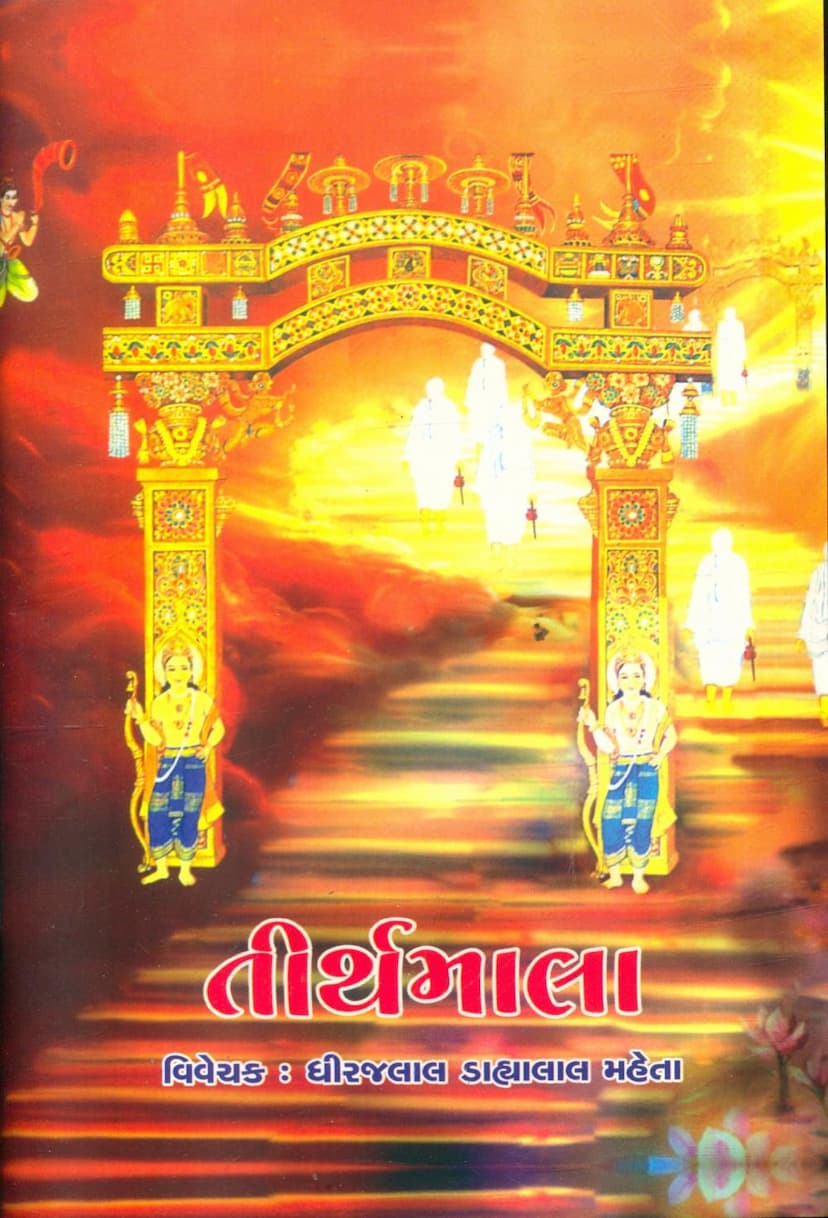Tirthmala
Added to library: September 2, 2025

Summary
This document is a Gujarati book titled "Tirthmala" authored by Dhirajlal Dahyalaal Mehta, published by Jain Dharm Prasaran Trust Surat. The catalog link provided is: https://jainqq.org/explore/006081/.
The book, as indicated by the title "Tirthmala" (meaning a garland of holy places or pilgrimages), is a poetic description and elaboration of a significant Jain pilgrimage undertaken by a large Jain sangh (community pilgrimage group).
Here's a comprehensive summary of the content based on the provided pages:
Core Subject:
- The book describes a grand Jain pilgrimage (Tirth Yatra) that commenced from Surat in Vikram Samvat 1755 (corresponding to 1755 - 543 = 1212 CE, but more likely 1755 + 243 = 1998 according to the text's dates, which place it around 1755 AD. The text explicitly states "સંવત સત્તર પંચાવને" referring to 1755. The actual CE year for VS 1755 is 1698 AD. However, the book mentions figures like Anandghanji, Yashovijayji, Chidanandji, Mohanvijayji, Devchandji, all of whom were active in the 17th and 18th centuries, suggesting the dates might be more accurately in the range of 17th-18th century AD rather than 12th century CE.)
- The pilgrimage was undertaken under the spiritual guidance and presence (નિશ્રા) of Param Pujya Gyanvimal Surishwarji Maharaj Saheb.
- The pilgrimage was characterized by adherence to the "Ch'hari Palit" principles, which are explained as six vows ending with "ri": ekal ahari (eating alone), padvihari (walking barefoot), sachitta parihaari (avoiding live vegetables), brahmachari (celibacy), bhumisnthari (sleeping on the floor), and avashyak kriyakari (performing essential religious duties). This adherence was maintained for six months.
Pilgrimage Route and Key Locations:
The sangh traveled extensively, visiting numerous Jain holy places. The route mentioned includes:
- Starting Point: Surat
- Major Stops/Regions: Bharuch, Kavi, Gandhar, Khambhat, Sanand, Viramgam, Sami, Shankheshwar, Radhanpur, Morwada, Sui village.
- Sindh/Border Region: From Sui village, they traveled to Nagar Parkar and Godi village (likely referring to the famous Godi Parshvanath temple).
- Marwar Region: Upon returning to Sui village, they proceeded to Tharad, Sanchor, and undertook the pilgrimage of the Panch Tirthi of Marwar.
- Rajasthan: From Marwar, they visited Bamalwada, Sirohi, and Anadara.
- Mount Abu: They ascended Mount Abu and visited the Dilwara temples and Achalgarh temples.
- Return Journey: After the Abu pilgrimage, they descended and passed through Palanpur, Mehsana, and Ahmedabad before returning to Surat, completing their six-month journey.
Content and Structure:
- Poetic Description: The book is a "Tirthmala," meaning it's a poetic narrative of the pilgrimage. It aims to inspire devotion and provide a beautiful and engaging account of the journey.
- Translation/Commentary: The author, Dhirajlal D. Mehta, has translated and provided commentary (વિવેચન) on the original Gujarati poem written by Gyanvimal Surishwarji.
- Spiritual and Devotional Focus: The text emphasizes the spiritual benefits of such pilgrimages, the joy and enthusiasm of the participants, and the importance of remembering and venerating the Tirthankaras. It highlights the virtuous nature of the sangh and its adherence to Jain principles.
- Historical Context: The book places the pilgrimage within a historical context, mentioning other prominent Jain scholars and poets of the 17th and 18th centuries, like Anandghanji and Yashovijayji.
- Detailed Itinerary (Poetic): The poem follows the journey chronologically, describing the arrival at each significant Tirth, the worship performed there, and the feelings of the pilgrims. Specific temples and Tirthankaras visited are mentioned, such as Chitamaniprashvanath in Surat, Neminath in Rander, Parshvanath and Rishabhdev in Bharuch, Mahavir in Vadgam, Vardhaman Swami in Gandhar, Padmprabh in Sanand, Parshvanath in Kavi, Gaadariaya Parshvanath in Mandal, Zotinga Parshvanath in Mujpur, Shankheshwar Parshvanath, Rishabhdev in Soi village, and extensively the temples on Mount Abu (Vimal Vasahi, Lun Vasahi, Bhimashah temple, Achalgarh).
- Godi Parshvanath History: A significant portion of the latter part of the document is dedicated to the history and legends surrounding the Godi Parshvanath idol, including its origins, its disappearance and reappearance, and its connection to merchants like Meghasha and the rulers of the region. It details the journey of the idol and its eventual installation in present-day Waw.
- Author's Intent: Dhirajlal Mehta expresses his desire that readers will repeatedly read and contemplate this booklet, deriving joy and inspiration to undertake similar virtuous deeds.
Publisher and Publication Details:
- Publisher: Shri Jain Dharm Prasaran Trust, Surat.
- Author: Dhirajlal Dahyalaal Mehta (from Sui village).
- Publication Year: Veer Samvat 2542 / Vikram Samvat 2072 / 2016 CE.
- Price: Rs. 50.00.
- Other Publications: Page 6 lists many other Jain religious and philosophical books published by the same trust, covering topics like Jain principles, rituals, dictionaries, philosophical works, and the Karmagranthas.
In essence, "Tirthmala" by Dhirajlal D. Mehta is a devotional narrative that meticulously chronicles a historical Jain pilgrimage, celebrating the spiritual journey, the adherence to Jain principles, and the grandeur of the visited holy sites, with a particular focus on the legendary Godi Parshvanath idol.